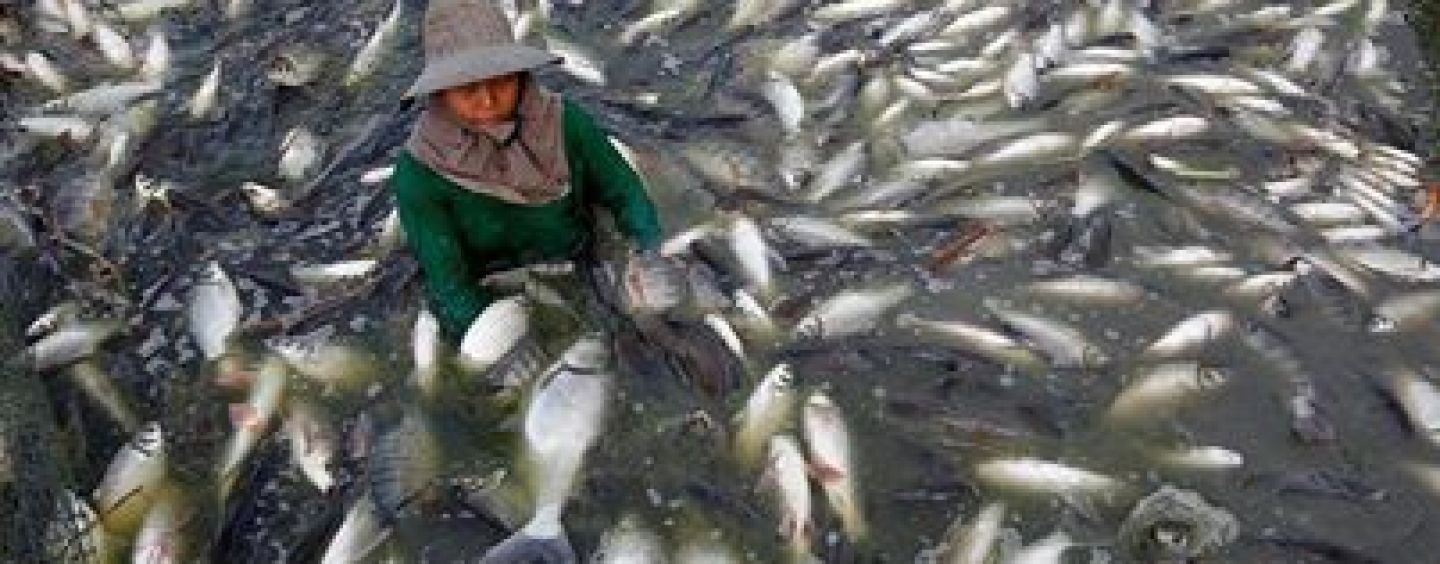
Beware, Tilapia Imported From China Is Raised On Feces! You Gotta Read How The FDA Defends Letting Americans Consume This!
by Tj Sotomayor June 3, 2014 6 commentsThe Feces Hits The Fan!
Tommy Sotomayor Says: While going through an article today that I saw on facebook, I couldnt believe what I was reading. You guys know that I am trying to eat a healthier diet and part of that consist of now eating so much red meat.
One of the alternatives to this is to increase your intake of fish and vegetables. Yes this is hard because I love meat but one of the fishes that I really enjoy eating is Tilapia. Its a white fish, flakey and tender and it was one of the first fishes that I ate and liked.
Now with all of the things people are telling me that are wrong with eating meat, how can we not look at the things that are going on in the Asian markets with seafood like having mercury in the shell fish and now the story that is below. Please read and act accordingly!
—————————————————————From WorldTruth.TV——————————————————————-
Small farms, high demands and lax oversight are inspiring fish farmers in China and Southeast Asia to feed their fish, especially tilapia, with animal feces.
TRUE:
In many cases, fish farmed in Asia and imported to the US have been raised on diets of chicken and pig feces
Tilapia is a flat, white fish that comes in nearly a hundred different species, is cheap to raise, easy to cook and recently became the fourth most-commonly consumed fish in the United States, behind shrimp, tuna and salmon. About 82 percent of the United States’ tilapia comes from China, according to USDA documents. But a simple online search of the subject reveals numerous alarming accusations involving Asian fish — particularly tilapia — being raised on diets of animal manure, and thus turning into magnets for food-borne illness. MSN News spoke with a leading food-safety scientist who said that, in fact, Chinese tilapia’s reputation for being unsafe to eat is quite well-deserved.
“While there are some really good aquaculture ponds in Asia, in many of these ponds — or really in most of these ponds — it’s typical to use untreated chicken manure as the primary nutrition,” Michael Doyle, director of the Center for Food Safety at the University of Georgia said. “In some places, like Thailand for example, they will just put the chickens over the pond and they just poop right in the pond.”
Asked to estimate what percentage of Chinese tilapia are raised using animal feces as food, Doyle said “I’d say roughly 50 percent.”
Feeding fish animal feces makes them highly susceptible to bacterial infections like salmonella and E.coli, Doyle said. Furthermore, he said that the large amount of antibiotics that are given to the fish to ward off infections makes the strains of salmonella and E.coli that the fish do catch extremely hard to eliminate.
“It’s incredible to see how much of these antibiotics are applied, and they leave large residues of antibiotics in the ponds,” Doyle said. “We have multiple antibiotic-resistant strains of salmonella coming in with these fish.”
Farmed fish now more common than farmed beef
Last month it was announced that farmed fish had overtaken farmed beef in terms of worldwide production for the first time in recorded history. This watershed moment for human food consumption was made possible by a vast network of fish-farming operations that allow enormous quantities of seafood to be raised in a minimal area and with minimal resources.
According to reports, in China and other Asian countries like Vietnam and Thailand, intense demand for farmed fish and cutthroat competition among farmers drives many of these farmers to cut corners. Feeding the fish with pig and chicken feces is much cheaper than using standard fish food.
An explosive Bloomberg News story published in October of last year and headlined “Asian Seafood Raised on Pig Feces Approved for U.S. Consumers” revealed in graphic detail fish farms and packing plants in China and Vietnam that are rife with filth and disease, and U.S. inspectors doing what appeared to be a poor job of stopping the tainted fish from entering the food supply. According to the piece, 27 percent of seafood consumed in in the United States comes from China, and yet the FDA only inspects 2.7 percent of the fish that gets imported. Of the fish inspected, the FDA has reportedly rejected 820 Chinese seafood shipments since 2007, including 187 that contained tilapia.
FDA defends inspections
In response to questions from MSN News about imported Asian seafood, the FDA defended its practices in an emailed statement, which reads as follows:
“The FDA’s priority is to ensure that both domestic and imported seafood sold in the United States is safe. The agency uses a multifaceted and risk-informed seafood safety program that relies on various measures of compliance. For imported seafood, these measures include inspecting foreign processing facilities, sampling seafood offered for import into the United States, domestic surveillance sampling of imported products, inspections of seafood importers, evaluations of filers of seafood products, foreign country program assessments, and information shared from our international partners and FDA overseas offices.”
“Seafood processors and aquaculture farmers are required to have controls in place to keep hazards out of seafood. The FDA conducts targeted risk-based testing, taking action when it finds violations.”
Despite the FDA’s assurances, Doyle said he recommends consumers pay attention to the country of originof their seafood, which grocery stores are required by law to display.
“Personally, I always stick to seafood that’s caught in the Gulf of Mexico,” Doyle said.
UPDATE: Pressed for more details on whether seafood imported from Asia receives, or deserves to receive, more scrutiny than seafood from other regions, FDA spokesperson Theresa Eisenman flatly denied that the widespread practice of feeding feces to farmed fish occurs.
“We are not aware of evidence to support the claim that this practice is occurring in China,” Eisenman wrote to MSN News. “Both domestic and imported seafood products are required to meet the same food safety standards. If FDA had information that an aquaculture product was raised in a manner that would violate FDA’s food safety requirements, that product would not be allowed entry into the United States.”
Eisenman wrote that as far as her agency is concerned, the only food-safety issue specific to Chinese seafood has been the types and levels of antibiotics used on the fish. An official FDA “Import Alert” was issued on June 27, 2013, that names China as having frequently used potentially carcinogenic antibiotics on its fish farms. The alert vows that the agency will stop any shipments of fish that contain antibiotics like malachite green, nitrofurans,fluoroquinolones, and gentian violet.











6 Comments so far
Jump into a conversationDisgusting!
damn, and I used to like eating fried tilapia.
What about shrimp? Don’t they swim in dirty (shit) water or something like that in China? I forget. I gotta look it up again.
Catfish too. Chinamen nearly put the South out of the catfish farming business a few years back. It’s a fraction the price, what do people expect?
Nasty asses! Stank bitches, er, fishes.
Oh well. No more tilapia for me I guess.
Only registered users can comment.